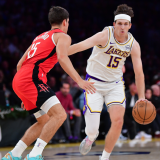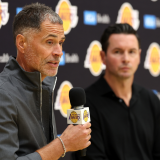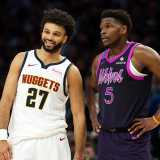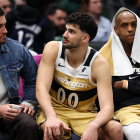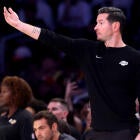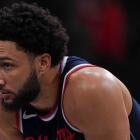Suns tried to build a superteam for an NBA that no longer exists
Talent no longer trumps all in the 2024 NBA, and the Suns have a bleak future because of it
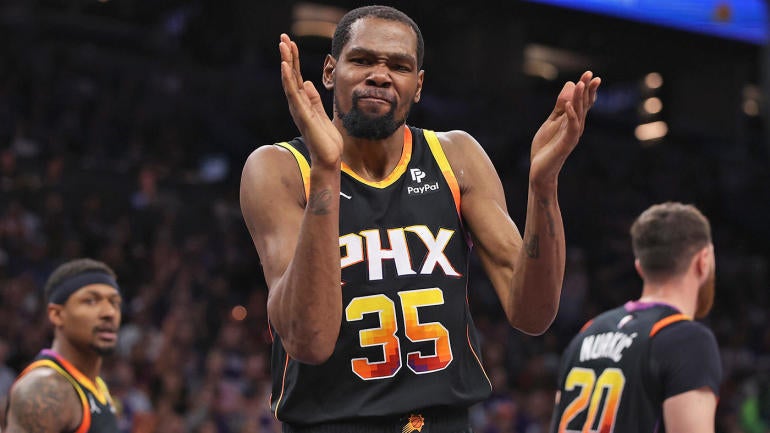
It might not seem like it considering their embarrassing first-round exit (a 4-0 sweep to the Timberwolves), but the easiest historical comparison for the 2023-24 Phoenix Suns, by far, would be the 2010-11 Miami Heat. Just consider the surface-level similarities:
- Both teams united three All-Stars in a very short span of time that had seemingly overlapping skill sets. This much was obvious where Phoenix was concerned, but it has largely been forgotten just how questionable the fit of LeBron James, Dwyane Wade and Chris Bosh looked on paper. All three ranked between 13th and 18th in mid-range shots per game in the season prior to uniting, and for their careers to that point, all three shot below 33% on 3-pointers.
- Both teams were so committed to the idea of a star trio that they were willing to build their entire balance sheet around it. The 2010-11 Heat were only able to pay three players aside from James, Wade and Bosh a salary above the minimum (Mike Miller, Joel Anthony and Udonis Haslem). The Suns also entered the season with three players earning between a minimum and a maximum contract in Jusuf Nurkic, Grayson Allen and Nassir Little, and they managed to cobble together enough minimum money to get a fourth (Royce O'Neale) at the deadline.
- Both teams exhausted their asset bases to put these teams together. The Suns traded Mikal Bridges, Cam Johnson and control over five first-round picks to Brooklyn for Kevin Durant along with four first-round swaps to Washington for Bradley Beal. The Heat gave up two first-round picks apiece for James and Bosh in sign-and-trades that were necessary for salary structure, and they needed to trade all of their players except for Anthony to clear the cap space needed to add them in the first place.
- Both star trios were built around one former MVP (James for Miami, Durant for Phoenix), one hometown player who had led that team to the Finals (Wade for Miami, Devin Booker for Phoenix) and one All-Star who had spent his career to that point playing for bad teams (Bosh for Miami, Beal for Phoenix).
- Neither star trio featured a traditional, rim-protecting big man. While both included plenty of ball-handling, neither had a traditional point guard either.
You could argue about some of the finer points here. Miami's trio had fewer age concerns, more of a defensive track record and was probably considered a shade more talented at the time, but the basic philosophy that guided both organizations to their superteams was the same. On a fundamental level, it was an attempt to out-talent the rest of the NBA.
That was an achievable goal in 2010. Super-teams didn't fully exist as a concept yet outside of Boston, whose three best players were all in their mid-30s. The league wasn't nearly as deep, and it wasn't as smart, either. The 2011 Rockets had a top-five offense with Kevin Martin as their leading scorer because they were one of the few teams to optimize their shot-selection. Miami's fourth-leading scorer on the way to the 2011 Finals was Mario Chalmers at 7.8 points per game.
That number only looks crazier when you remember that the 2023 champion Nuggets had six players average double figures in the postseason. The Suns tried a 13-year-old trick in an older, wiser league. Miami's investment in three stars was unprecedented at the time.
Today, you could argue that one-third of the league is as all-in as the Suns are. Heck, every team in Phoenix's division has tried the super-team gambit in the last few years except for Sacramento. There are teams today like Boston that practically have entire lineups filled with All-Star-caliber players, and theirs were much more thoughtfully united with skill-set diversity in mind.
The league's collective basketball IQ is lightyears ahead of where it was in 2011. Phoenix has one of the most talented offensive trios in NBA history. Its offense barely snuck into the top 10 because the Suns ranked second in the NBA in mid-range shot attempts, but 24th in 3-point attempts and 28th in restricted area attempts. As valuable as contested mid-range shot-making is late in games, we now know offenses fare far better when they avoid tough shots most of the time rather than make them. The modern NBA is simply too smart and too deep to be out-talented by three players who all do the same things.
In the end, the league was good enough even in 2011 to prevent itself from being dominated by three players alone. The Heat lost the 2011 Finals to the Mavericks. And that is where our two prospective super-teams fully diverge. The NBA of 2011 was designed to allow super-teams to improve and slowly accumulate depth over time. The Heat used the mid-level exception to sign Shane Battier, a starter on their two subsequent championship teams, in the summer of 2011. They followed that up by using their 2012 mid-level exception on Ray Allen, who went on to make arguably the biggest shot in Finals history. They included cash in their 2011 draft night trade for Norris Cole.
These aren't tools that will be available to the Suns moving forward. The NBA's new second luxury tax apron prohibits teams in Phoenix's salary range from using a mid-level exception. They cannot include cash in trades, and trade rules in general become enormously restrictive. Moving forward, the Suns won't be able to aggregate salaries in trades. They will have to send out at least as much money as they take in. They'll even have to worry about future first-round picks getting frozen at the end of the first round if they stay in this salary range long enough.
The league learned from the super-team model that the Heat started, and now, the CBA specifically aims to make it harder for such teams to add or retain depth. While the Suns can use Bird Rights to retain their own players, it is worth noting that the luxury tax, especially at the repeater level, is about to get significantly more punitive on a purely financial level for teams that go deeper into it like the Suns have. Even keeping this version of their roster together is going to cost a small fortune.
Phoenix will have presumably late first-round picks (due not to their success but their incessant swapping) in even-numbered years moving forward, including No. 20 in this year's weak class. Otherwise? Their only real avenue to adding talent will be minimum contracts. If that were a reliable way to build a supporting cast, well, the Suns wouldn't be in this mess.
Every offseason features a few minimum-salary home runs. Kelly Oubre and Derrick Jones Jr. stand out from 2023 free agency. But most minimum signings turn out as Phoenix's did to be low-end rotation players, if they can contribute at all. You're going to hear quite a bit in the next few months about how the Suns need a true point guard and a defensive anchor to turn this around for next year. Short of breaking up their big three, they have no way of actually getting those players.
And that's the dilemma facing the Suns right now. This super-team they've assembled doesn't work. It's never going to work. The league simply isn't designed for it to work in the ways that it might have a decade earlier. Yet, there's no real alternative here.
A second Beal trade seems unlikely. He's about to turn 31, he has three years of super max money left on his deal, he comes with a number of injury concerns and also has a no-trade clause. Even if the Suns could move him, it's hard to imagine them doing so for the kinds of players they need right now.
Durant would fetch more in a trade to be sure, but his size alone makes him the most important star to be kept in a possible two-star approach. His value today likely isn't close to what it was in February, 2023, either. He will turn 36 before opening night of next season and has an even scarier injury history than Beal. He's getting to the rim far less than he did at his peak. His 2022 and 2023 postseasons were relative disappointments, as his efficiency dipped significantly in both.
Durant improved slightly against Minnesota, but he is no longer creating good team offense for teammates out of thin air as he did in 2021. He's still an All-NBA Player. His shooting suggests he still will be next year at least, provided he stays healthy. But any team acquiring him would need to believe itself ready to compete for a championship right now. How many such teams, with the assets it would take to make the Suns a contender as well, even exist? Maybe the Knicks?
And then there's Booker. Players as good as he is and as young as he is do not get traded unless they ask to be. If winning is his sole goal, it's not hard to imagine Booker looking at Phoenix's desolate future and pulling the trigger now. But in the likelier event that he's satisfied, there just isn't isn't a win-now package out there big enough to put a winner around the Beal-Durant duo in Booker's absence. Heck, given the injury risks those two pose, Booker might be a necessity as a floor-raising regular-season player alone.
The nuclear option for most teams in Phoenix's situation is a true blow up. Doing so when you don't control your own picks, as Phoenix won't for the rest of the decade, is an incredibly scary proposition. Sure, the Suns could get picks back for Durant and Booker... but those teams would have Durant and Booker, which would probably prevent the picks they send back from becoming all that valuable.
Even the distant future picks that actually might amount to anything of note leave you in purgatory while you wait. Imagine being the current Brooklyn Nets... only without Mikal Bridges or a glamour market with which to attract more stars. That's probably the likeliest outcome for a Suns team that blows it up. Even if they get it right, half a decade of irrelevance is on the table while the pick up the pieces of this failed roster.
If this all sounds grim... well... yeah. It should. This is bleak. It is one of the bleakest sets of circumstances facing any team in the NBA right now. It's only going to get bleaker. Just look at the bottom of the Western Conference this season. The Memphis Grizzlies are younger, better and more thoughtfully constructed than the Suns are. If they are healthy and whole next season, they're passing Phoenix. Houston's young roster finished eight games below the Suns, and the Rockets could easily make a significant trade this offseason if they so choose. In that case, the Rockets might leap the Suns as well. If the Spurs choose to go all-in? Well... you've seen Victor Wembanyama. If he isn't already good enough to take a team into the playoffs by himself, he soon will be.
There just isn't a good answer here. There's no an obvious pivot or strategic approach that can fix this for the Suns. They misunderstood where the league was when they traded for Beal and they misunderstood where it was going when they traded for Durant. Sure, it's possible that they nail minimum-salary free agency this summer. Maybe they unearth their undrafted equivalent to Austin Reaves or Naz Reid this summer, or someone makes an unexpected deal for the meager assets the Suns have left.
But the most likely outcome here is that the Suns were simply wrong. They built a team for an era that has ended and now they're doomed to ride this one out as a fringe contender before eventually collapsing without reaching the height that the Heat did when they tried this 14 years ago. Pat Riley understood the league he was competing in. Mat Ishbia didn't.
Looking for more NBA coverage? John Gonzalez, Bill Reiter, Ashley Nicole Moss and special guests dive deep into the league's biggest storylines daily on the Beyond the Arc podcast.



